





Celebrate the 10th anniversary of the George Washington Presidential Library on September 30. RSVP now to enjoy an unforgettable evening featuring dinner, fireworks, and live entertainment. Visit mountvernon.org/makinghistory.

Join us November 2–4 for the George Washington Presidential Library’s fall symposium. “The Great Experiment: Democracy From the Founding to the Future” will assemble noted historians, authors, journalists, and leaders in thoughtful conversation. Learn more at mountvernon.org/democracy.

CONSULTING EDITOR:
Norie Quintos
DESIGNER Jerry Sealy
PRODUCTION MANAGER: Matt Briney
VISUAL RESOURCES: Dawn Bonner
CONTRIBUTING WRITERS:
Julie Almacy
Dawn Bonner
Matt Briney
Anne Fertig
Margaret Loftus
Kristen Otto
Jeremy Ray
Jennifer Seiter
Mount Vernon magazine is published three times a year by the Mount Vernon Ladies’ Association, the nonprofit organization that owns and manages George Washington’s estate. We envision an America where all know and value the singular story of the father of our country. Ever mindful of our past, we seek innovative and compelling ways to tell the story of George Washington, so that his timeless and relevant life lessons are accessible to the world.
This publication is produced solely for nonprofit, educational purposes, and every reasonable effort is made to provide accurate and appropriate attribution for all elements, including historical images in the public domain. All written material, unless otherwise stated, is the copyright of the Mount Vernon Ladies’ Association. While vetted for accuracy, the feature articles included in this magazine reflect the research and interpretation of the contributing authors and historians.
George Washington’s Mount Vernon P.O. Box 110, Mount Vernon, Virginia 22121
All editorial, reprint, or circulation correspondence should be directed to magazine@mountvernon.org.
mountvernon.org/magazine

The light-filled stacks in the reading room of the George Washington Presidential Library are lined with books and documents related to Washington’s world, from 18th-century decorative arts to military history to political philosophy. At one end of the hallway hangs a portrait of Martha Washington. (See the cover of the Spring 2023 magazine.) At the opposite end is a portrait of George Washington. (See it up close on page 11.) Photo by Anice Hoachlander.

The George Washington Presidential Library at Mount Vernon, more than 200 years in the making, celebrates its 10th anniversary
Plus: 10 facts about the Library
By Douglas BradburnWithin the Library’s special collections are a wealth of treasures, from Washington’s copy of the Acts of Congress to his favorite botanical magazine
Curated by Dana Stefanelli
Good thing the women who saved Mount Vernon had the foresight to document their story, too
By Rebecca BairdWashington’s
ledger. See page 27.
Free Days fun, a new podcast, the quest for duplicate editions, a revealing interview, and more
Rembrandt Peale’s idealized portrait of Washington helped cement the first president’s iconic status
For Clark Musser, it’s about expanding access to the lessons of American history
An elementary school teacher in Calvert County, Maryland, uses her school library to make history come alive
| Shows of Support
A pair of birthday bashes, Founders Committee fundraiser, and a campaign update
44 | Featured Photo Washington’s library, at Mount Vernon, as it was in 1895

George Washington’s Mount Vernon estate is owned and maintained in trust for the people of the United States by the Mount Vernon Ladies’ Association of the Union, a private, nonprofit 501(c)(3) organization founded in 1853 by Ann Pamela Cunningham.
Margaret Hartman Nichols, Regent
Andrea Notman Sahin, Secretary
Anne Neal Petri, Treasurer
Cameron Kock Mayer, Louisiana
Maribeth Armstrong Borthwick, California
Ann Haunschild Bookout, Texas
Virginia Dawson Lane, South Carolina
Laura Peebles Rutherford, Alabama
Susan Marshall Townsend, Delaware
Anne Neal Petri, Wisconsin
Liz Rollins Mauran, Rhode Island
Ann Cady Scott, Missouri
Sarah Miller Coulson, Pennsylvania
Andrea Notman Sahin, Massachusetts
Catherine Hamilton Mayton, Arkansas
Helen Herboth Laughery, Wyoming
Catherine Marlette Waddell, Illinois
Lucia Bosqui Henderson, Virginia
Mary Lang Bishop, Oregon
Elizabeth Medlin Hale, Georgia
Ann Sherrill Pyne, New York
Karen McCabe Kirby, New Jersey
Hilary Carter West, District of Columbia
Adrian MacLean Jay, Tennessee
Sarah Seaman Alijani, Colorado
Susan Brewster McCarthy, Minnesota
Douglas Bradburn, President & CEO
Joe Bondi, Senior Vice President, Development
Matt Briney, Vice President, Media & Communications
Phil Manno, Chief Financial Officer
Susan P. Schoelwer, Executive Director, Historic Preservation & Collections & Robert H. Smith Senior Curator
Patrick Spero, Executive Director, George Washington Presidential Library
Joseph Sliger, Vice President, Operations & Maintenance
K. Allison Wickens, Vice President, Education
In 1797, Washington wrote to his friend James McHenry, “I have not houses to build, except one, which I must erect for the accommodation and security of my military, civil and private papers, which are voluminous and may be interesting.”
Well, it took more than 200 years, but the Mount Vernon Ladies’ Association (MVLA), along with thousands of supporters, fulfilled the dream. The George Washington Presidential Library at Mount Vernon opened its doors on a beautiful September morning in 2013. Dignitaries and supporters gathered in front of the great new building. The late, legendary historian David McCullough gave the keynote address, and country stars Amy Grant and Vince Gill harmonized on “America the Beautiful.” It was only my fifth week at Mount Vernon as the Library’s founding director.
In 10 years, the Washington Library has established itself as the preeminent center for the study of George Washington, fostering scholarship on the founding era of the United States and creating innovative educational programming for a variety of audiences.
This issue celebrates the achievements of the Library’s first decade. Dana Stefanelli, Ph.D., curator of special collections, pulls back the curtain on the Library vault, which houses a priceless collection of George and Martha Washington letters and manuscripts, a large portion of George Washington’s original library, and much more.
The Library supports and maintains the archives of the MVLA, encompassing records of the institution’s preservation, management, and governance of the estate from 1852 to the present. MVLA archivist Rebecca Baird relates the story of how America’s oldest historic preservation organization maintained and continues to maintain its own records.
A center for robust public programming, the Washington Library hosts regular conversations with authors of topical books, multiday symposiums with renowned scholars, thematic speaker events, and international conferences. The Library also houses the George Washington Leadership Institute, which holds programs for various groups focused on teaching the leadership qualities of America’s first president.
The Library has welcomed many distinguished visitors, including King Felipe VI and Queen Letizia of
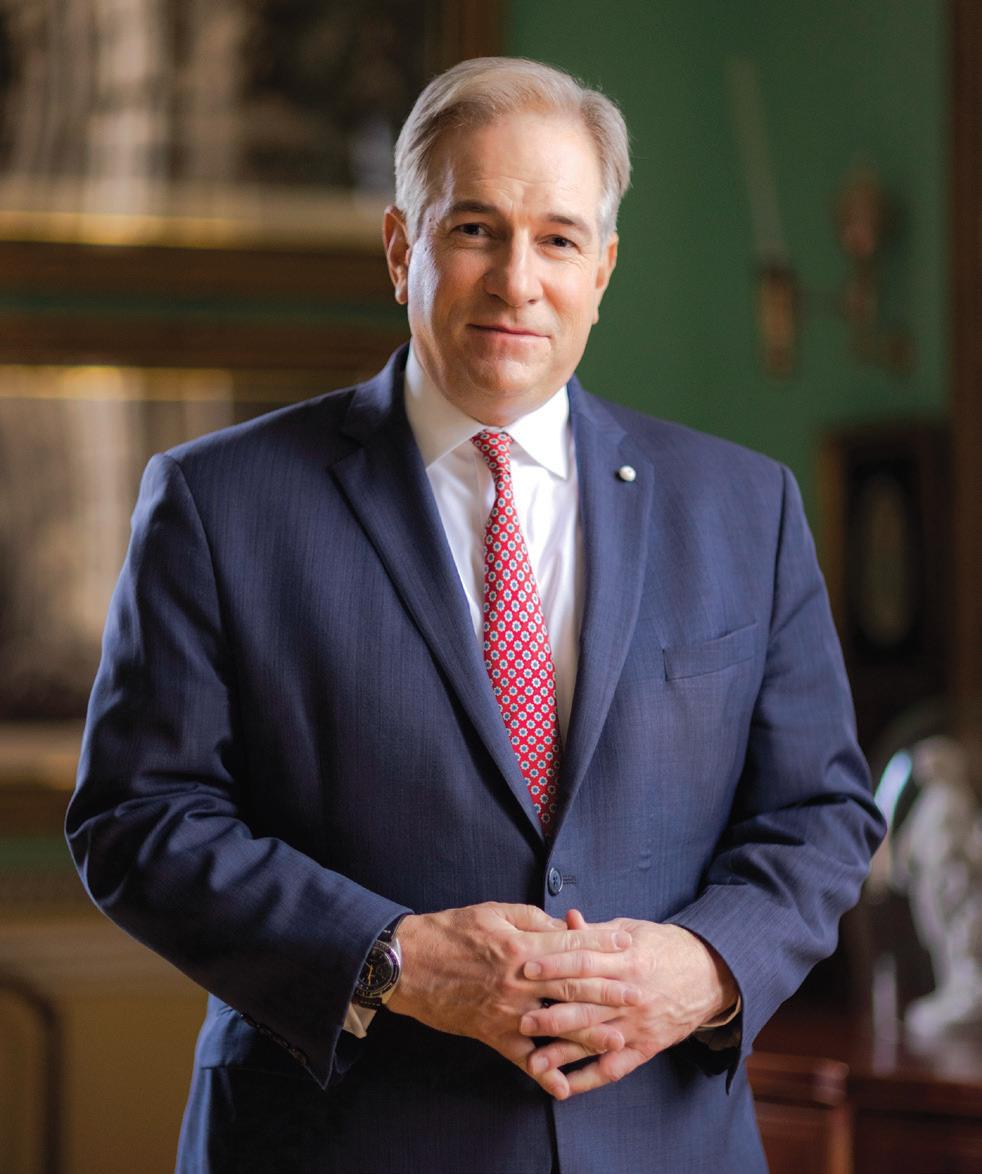
Spain, former German chancellor Angela Merkel, former first lady Melania Trump, Supreme Court justices Sonia Sotomayor and Neil Gorsuch, and Ukrainian president Volodymyr Zelenksy, as well as the first spouses of the states and a host of ambassadors, military officials, and members of Congress.
As the Library begins its second decade, we are just getting started. Patrick Spero, Ph.D., has taken the helm as the Library’s new executive director. We look forward to watching him grow the Library collections and develop new programs that expand knowledge of the life, leadership, and legacy of George Washington. Please join us as we celebrate this marvelous house of George Washington’s papers. By the way, Washington was right, his papers are “voluminous,” and certainly “interesting.”
My very best,
Douglas Bradburn

President and CEO

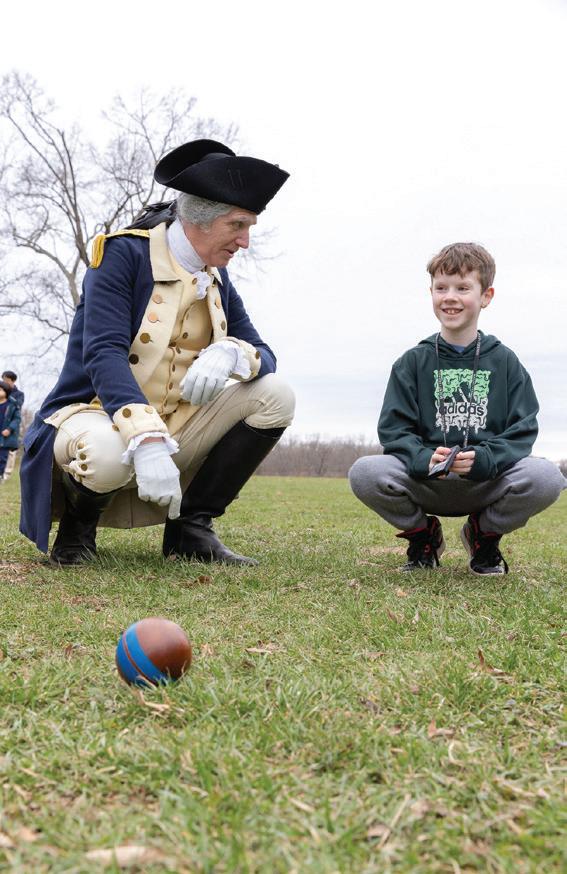
For the first time since the beginning of the pandemic in 2020, Mount Vernon returned to normal operations for its two annual Free Days, without a cap on the number of admissions and with the Mansion’s first and second floors open. The higher ticketing capacity (100 tickets every five minutes) on Monday, February 20, Washington’s Birthday Observed meant that nearly every guest had the option to tour Washington’s home. The estate hosted a second Free Day two days later, on his actual birthday. In all, the estate welcomed some 13,500 visitors over the two days.
Monday, February 20, began with a solemn and special presidential tribute at the Tomb. Guests then moved to the bowling green for special military demonstrations provided by the U.S. Army Military District of Washington, featuring the U.S. Army 3rd Infantry, the Old Guard Fife and Drum Corps, and the Commanderin-Chief’s Guard. “General Washington” (portrayed by Dan Shippey) was on hand to greet guests throughout the
day. On the other side of the grounds, the Washington Library hosted an open house for more than 600 visitors. Staff members spoke on topics such as famous visitors to the estate, Mount Vernon during the Civil War, forgeries of the founders’ writings, and the history of the Mount Vernon Ladies’ Association.
The following Wednesday, the estate once again waived admission fees for the public. Numerous chapters of the Sons of the American Revolution (SAR) and the Daughters of the American Revolution (DAR) had wreathlaying ceremonies at the Tomb. “General Washington” greeted guests on the 12-acre field, with Half Crown Bakehouse providing hoecake demonstrations. There was a performance by “General Washington” in the Robert H. and Clarice Smith Auditorium, a game of “Bowles with the General” on the bowling green, and, of course, birthday cake. As in years past, Mount Vernon also hosted another joyous and moving naturalization ceremony for new citizens of the United States.


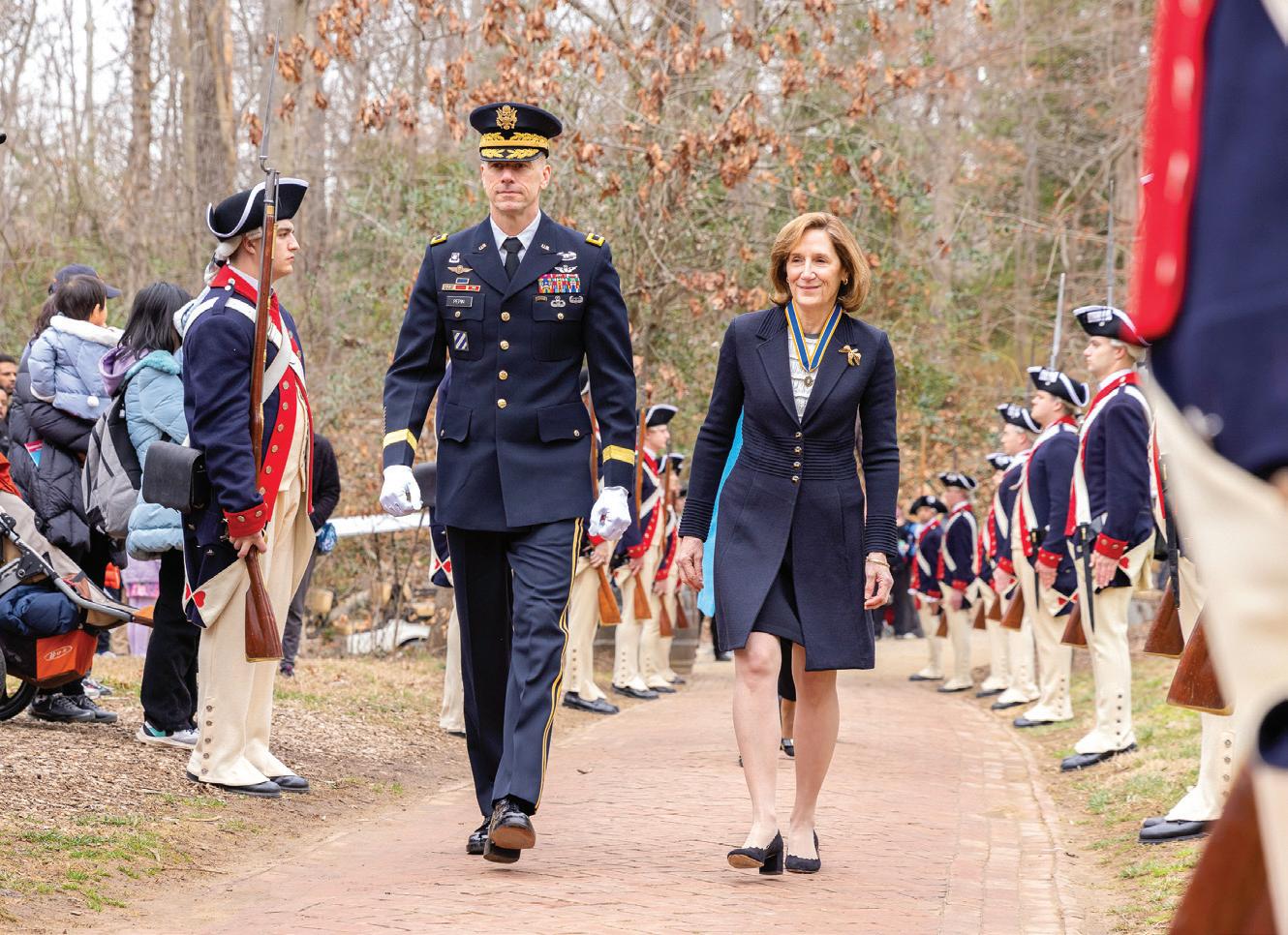
The character interpreter channels an enslaved woman who escaped Mount Vernon
Agraduate of the University of Mary Washington in Fredericksburg, Virginia, Timbila Kabre leans on her history degree, her acting experience, and the compelling nature of Ona Judge’s true story in interpreting the character for the many visitors who come through Mount Vernon.
How did you come to Mount Vernon? I originally interviewed for another position. But [a staff member] googled me and saw I had acting experience. So in the middle of my interview, he asked, “Do you also want to interview for a character interpretation position?” That
interview went really well, or else I wouldn’t be here today.
How do you research for a role like this?
It’s a lot of reading. It’s looking up and reading anything and everything that pops up about the name Ona Judge or variations like Oney or Ona Judge Staines. The book Never Caught, by Erica Dunbar, is probably my best resource on Ona Judge herself. And, of course, Mount Vernon has a lot of great resources on the enslaved community here.
What about Ona Judge’s story appealed to you? Following her escape, George Washington made two attempts to

reclaim her. It’s really impressive that she confronted that situation and said, “No, I’m not going to go.” And not only once; she did it twice. That’s always my favorite part of the story to tell, especially at the second attempt when Burwell Bassett, Jr. [a Virginia senator and nephew of Martha Washington] was at her doorstep and she said, “No.” I can only imagine how powerful she felt in that moment. And so I feel really powerful being able to retell that part of her story.
How important is it to tell the history of the enslaved community of Mount Vernon? Slavery is one of the most important things to talk about here at Mount Vernon. George Washington’s life would not have looked the way it did without the enslaved people working for him.
How do you engage visitors with the history at Mount Vernon? With younger students I often ask, “Do you do chores at home? If you do, here are the chores that Ona Judge does.” And they’re able to relate to Ona Judge in some way.
Are you working on any other characters?
I am working on Lucy Lee, the head cook in the Mount Vernon kitchen; and Phyllis Wheatley, a poet who was formerly enslaved and who wrote a poem about George Washington and corresponded with him.

Naming and unveiling ceremony at Mount Vernon for the USS Lafayette
On July 3, a ship naming ceremony took place at Mount Vernon, unveiling the future USS Lafayette, a Constellation-class guided missile frigate, representing the U.S. Navy’s next-generation small surface combatant.
The ship’s name is a tribute to the Marquis de Lafayette, the French military officer who volunteered to fight for the Continental army, and a recognition of his invaluable service during the American Revolutionary War. He was one of George Washington’s closest allies, known for his unwavering support and strategic brilliance.
Dignitaries attending the event included Secretary of the Navy Carlos Del Toro, who delivered remarks and revealed the sponsor of the USS Lafayette. Laurent Bili, French ambassador to the U.S., accompanied by his spouse, Sabine Raczy-Bili, was also in attendance, reaffirming the strong historical ties between France and the United States. Douglas Bradburn, Mount Vernon’s president and CEO, shared his appreciation for the enduring legacy of Lafayette and the deep-rooted connection between the two nations.
Reenactors portraying General Washington and the Marquis de Lafayette added a historical touch, transporting the audience back in time to the pivotal moments of the American Revolution.
In 2002, Congress made Lafayette an honorary U.S. citizen. Three previous Navy vessels have been named in honor of Lafayette: a sidewheel ironclad ram, a transport ship, and a ballistic missile submarine. The USS Lafayette, the fourth of the Navy’s new Constellation-class frigates, is scheduled to commission in 2029.

What did Washington write on his personal copy of the Constitution? What was he reading the night before he died? Who left behind messages inside some of Washington’s books?
The answers to these questions and more are revealed in Secrets of Washington’s Archives: Inside the Vault at the Washington Presidential Library Mount Vernon’s newest podcast and video series explores the treasures found inside the George Washington Presidential Library’s special collections. Librarians and historians share the hidden and oh-so-human stories found in the founder’s books, periodicals, and maps. [Also see story, page 22.]
Mount Vernon members will receive early access to episodes and members-only bonus content. Episodes are available on apps such as Spotify, Apple Podcasts, and Google Podcasts, as well as on the Mount Vernon website. Learn more at www .georgewashington podcast.com.
The quest to find duplicate editions of Washington’s books
After George Washington’s death, his personal library numbering approximately 1,500 volumes was widely dispersed. The majority of Washington’s original books are now owned by institutions scattered around the world. The Boston Athenaeum, for example, holds some 600 of Washington’s original books.
Mount Vernon holds 106 originals. While its top priority is to bring home Washington-owned books, it is sometimes more practical to acquire “matching editions,” i.e., books that are from the same printing as those Washington owned. As early as 1890, Mount Vernon began reconstituting Washington’s library through this approach, and the opening of the George Washington Presidential Library in 2013 inspired a renewed commitment to this effort. A reconstituted library would be an essential resource in the research
and study of Washington and the revolutionary times in which he lived.
Mount Vernon currently owns 500 matching editions. Staff continuously monitor sales to determine when a match may be available and conduct detailed research to confirm that an item is indeed a duplicate of the same edition that Washington owned.
These efforts are boosted by an informal group of Mount Vernon supporters across the country who help the Washington Library make the purchase or cover the cost of conservation, which is often needed. Mount Vernon donor Charles Tharp of Maryland has not only personally supported this effort but has also matched book topics to the interests of his friends and encouraged them to fund an acquisition for Mount Vernon.
Want to help? Register your interest with an email to matching-editions@mountvernon.org.

Textile gift: Thanks to the generosity of Mary Lang Bishop, Vice Regent for Oregon, the Costuming Department received four lengths of Pendleton woolen broadcloth for a new suit for Daniel Shippey, who portrays “George Washington.” Letter delivery: The archives received the donation of a letter written by Arete Johnson, an MVLA manager, promoting the cause of the Ladies’ Association. Dated August 9, 1854, the letter is the earliest example of this type of correspondence in the collections. Continuing ed: Mount Vernon welcomed 10 educators from the Washington, D.C., metropolitan area in March to learn about the estate’s architecture from Tom Reinhart, director of historic preservation. Lambing season: Spring was heralded with the appearance of lambs on the estate. The farm welcomed 34 lambs over four weeks.
BY THE NUMBERS
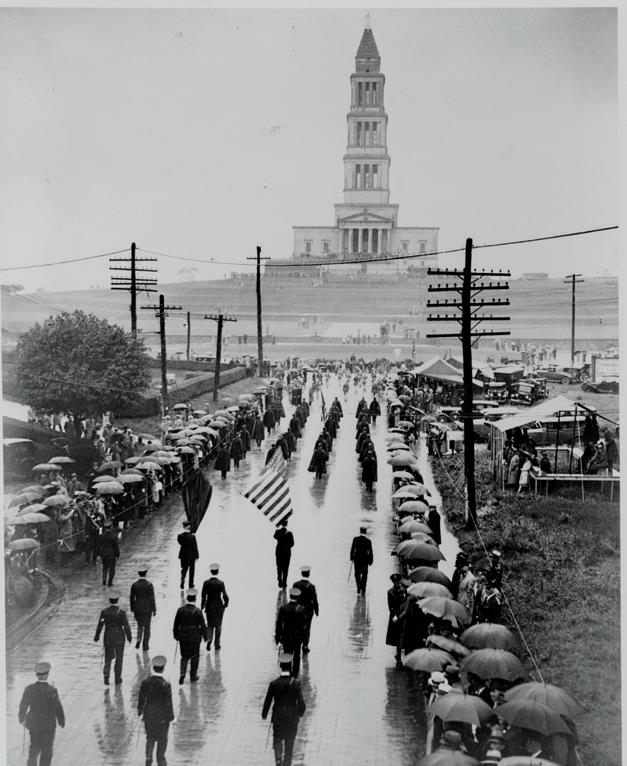
100
Number of years since the laying of the cornerstone at the George Washington Masonic National Memorial, in Alexandria, Virginia.
61
Number of newly minted United States citizens from 45 countries. These new Americans were naturalized in one recent ceremony at Mount Vernon.
16 Mount Vernon research fellowships awarded for 2023–2024. These funded opportunities are for researchers of the early American period.

A recent social media post about Washington’s mules was popular. Many commenters expressed surprise that Washington is considered the “Father of the American Mule.” A brief history:
While not the first proponent of mules in the U.S., George Washington was certainly the most famous. The early adopter began breeding mules after he received a stud jack (donkey) from the king of Spain in 1785. (A mule is a cross between a male donkey and a female horse.)
Washington was fond of horses, but believed that mules worked longer and harder and required less feed. In 1785, Washington’s inventories listed 130 horses and no mules. In 1799, 58 mules lived on Mount Vernon, and only 25 horses.
In recent years, Mount Vernon has employed a team of mules that plows fields, hauls compost, and pulls wagons. The estate also has an American Mammoth Jackstock that represents “Royal Gift,” the donkey Washington received from the king of Spain

Rembrandt Peale’s “perfect representation” of Washington helped cement the national hero’s iconic status

Rembrandt Peale, son of portraitist Charles Willson Peale, first painted George Washington in 1795 when Peale was only 17 years old. Almost 30 years later, the artist reworked his life portrait into one idealized image that depicted Washington in a stonework oval, or “porthole.” What emerged was as much icon as likeness. (He sold the original canvas to Congress in 1832.) Peale vigorously promoted this image—which he called George Washington, Patriae Pater (Father of His Country)—over the next three decades, executing at least 75 replicas (including this one) and several prints of it. By popularizing his “perfect representation” to icon status, Peale—an advocate of physiognomy, or the idea that external appearances revealed one’s true character— believed future Americans would be enlightened by Washington’s nobleness.

FAST FACTS
ARTIST: Rembrandt Peale (American, 1778–1860)
DATE: c. 1850
MEDIUM: Oil on canvas, carved gilt wood frame
ACQUISITION: Bequest of Luisita L. Cofer, 1956
ON VIEW: In the Washington Library
The original gilt wood frame—also designed by Peale—is decorated with a laurel crown, oak leaves, and fasces, Roman symbols of victory and power. ➋
LIGHTING
The portrait is lit from the upper proper right, but there is an overall glow that extends to the edge of the stonework framing device.
➌ REPRESENTATION
Peale incorporated what he considered were the best facial features of Washington life portraits by leading artists—his father, John Trumbull, Gilbert Stuart—and the sculptor Jean Antoine Houdon.
For Clark Musser, it’s about expanding access to the lessons of American history

Having devoted decades of his life to his law practice, Clark Musser was considering his next chapter back in 2004 when he came across a remark from the late David McCullough that struck a chord. The historian had asserted that you can’t love America without knowing its history any more than you can love someone you never met. Inspired, he delved deep into the study of the early Republic with much of the same fervor that drove him to build his own
law firm and academic career at the University of Oklahoma.
Musser read all the top scholars, from Ron Chernow to Gordon Wood, as well as the works of the founders themselves, and what soon became clear to him was the singularity of George Washington. “I always came around to who deserves [the most] credit—it was Washington,” he says. “He was transformative and indispensable. Our nation today is what he put into motion two and a half centuries ago.”
As a law professor, he’d found that the best way to learn a subject was to

teach it, so he decided to spread the word about Washington by telling “stories,” as he calls them—essentially history lessons that fill in the gaps left after the formal education of many Americans—to civic organizations, books clubs, etc. He even appeared on a local PBS affiliate show called Oklahoma Horizons. “By sharing these stories, I began to understand better and better,” he explains. “I wanted everyone, and particularly those younger [generations], to appreciate our nation.”
Today, Musser gives fewer talks— about a half dozen a year—but his passion for educating the public about Washington has only grown. He and his wife, Kay, have since become very involved with Mount Vernon. The couple supported the George Washington Teacher Institute (GWTI), which brings educators from across the country to Mount Vernon for an intensive five days of professional development focused on the most effective tools and training for incorporating Washington into their classrooms.
But the Mussers’ contributions don’t end there. They underwrote the Gordon Wood Symposium in 2020, a one-day event that brought together constitutional scholars

whose work had been shaped by the historian and Pulitzer Prize–winning author. In 2021, the couple funded a six-month research fellowship at the Library, and in 2022, they launched the inaugural scholarships for the GWTI Graduate Credit Program, which builds on skills taught in the residency program through a threecredit graduate course at George Mason University. “We wanted to be a part of Mount Vernon, in one small way, and the scholarships seemed to comport with everything we deemed important,” Musser says.
Since becoming involved with Mount Vernon, the couple has made a point of making a pilgrimage to the estate every year, with few exceptions. “I relish the grounds, the surroundings, but above all, the symbolism of the most important man in American history,” Musser notes. “To walk the [piazza] where Washington once stood to marvel at the rising sun, and to stroll the grounds and gardens of his estate that were so integral to his being. All elevate my spirits, immeasurably so.”


Returning home to Mount Vernon in 1797 after his presidency, George Washington reflected on what he’d like to accomplish in his remaining years in a letter to his friend, and former secretary of war, James McHenry. “I have not houses to build, except one,” he wrote, “which I must erect for the accommodation and security of my military, civil and private papers, which are voluminous and may be interesting.” His papers contain the raw materials of America’s revolutionary birth. Interesting indeed, and fragile, the papers needed to be kept safe.
This September, Mount Vernon celebrates the 10th anniversary of the realization of that pursuit. The Library may have taken more than two centuries to establish, but in the last decade, the George Washington Presidential Library has become an integral part of Mount Vernon as we know it. Today, it serves not only as a safe haven for those papers and extensive archive collections that tell the story of Washington and the Revolutionary and founding eras, but also as a dynamic education hub that teaches multiple audiences in innovative ways about the lessons, values, and warnings embedded in the history of the founding of the United States.
After a campaign that raised $106 million for the building and endowment—remarkably, in the midst of the Great Recession (2007–2009)—the Mount Vernon Ladies’ Association (MVLA) broke ground in 2011. The result was a monumental 45,000-square-foot contemporary building that leans more arts and crafts than colonial to complement, rather than compete with, the architecture of Mount Vernon itself, with subtle nods to the estate, like matching stone to the gristmill, and a long columned terrace, which echoes the Washingtons’ piazza. There’s also more than 25,000 square feet of paneling from a single sycamore tree, which—when it was harvested—was more than 300 years old, a bridge from Washington’s time to ours. Inside, six larger-than-life busts of the principal founders preside over the reading room, speaking to the
Library’s mission as a research and scholarship center to study the Revolutionary era and an institute to help American leaders learn from Washington’s example. I joined Mount Vernon as the founding director of the library five weeks before its grand opening on September 27, 2013. It was an exciting time. On the eve of opening day, we threw a spectacular party on the east lawn, with singers Amy Grant and Vince Gill performing, to celebrate the donors and Board members who had made it happen, including the Library’s namesake, the late Fred W. Smith, longtime executive officer of the Donald Reynolds Foundation, and a great supporter of Mount Vernon who donated the first major gift to the project. The following day—with a federal government shutdown looming—I introduced the first lecturer, the American historian David McCullough, who referred to the can-do attitude of the MVLA and joked, “Maybe we should ask the Ladies’ Association of Mount Vernon to take over [the country].”
Given the accomplishments and impact of the Library a decade later, McCullough may have been on to something. With goals that first year both mundane and aspirational, the Library team hit the ground running. On the collections side, we acquired some remarkable manuscripts right off the bat; it was the beginning of a 10-year run of some extraordinary acquisitions. One of the first was a previously unknown 18th-century ledger belonging to Mount Vernon neighbors William and George William Fairfax, which notes in detail furnishings acquired in England for Washington. These descriptions enabled preservationists to re-create the blue damask furniture suite in Mount Vernon’s Front Parlor—an example of the power of a manuscript and its ability to help preserve and tell the estate’s stories.
Other rare and valuable documents followed, notably correspondence between Washington and François Jean de Chastellux. Chastellux was the third in command of French general Rochambeau’s army and a critical liaison between the allies who became a dear friend to the American general. The letters, which had been in the marquis’s family since the 1780s and were presumed lost, were acquired in 2016 and illuminate a personal
side of Washington unseen in historical documents until now. In them, Washington expounds on a multitude of topics, from marriage to his hopes and dreams for the country. There’s warmth, too, such as when he tells the marquis, “Never in my life did I part with a man to whom my Soul clave more sincerely than it did to you.” The correspondence was part of a vast trove of papers, including letters to Thomas Jefferson, Baron Von Steuben, and Voltaire, much of which the Chastellux family is allowing the Library to digitize for the collection.
These are but a few of the items the Library has amassed over the past decade. Other letters, books, and manuscripts—procured in part with an annual rare book and manuscript endowment of $250,000, raised by the MVLA in the initial Library campaign—shed new light on the leadership and education of George Washington. The Library now has one of the best Revolutionary War map collections in the country, given by collector and scholar Richard H. Brown. Such acquisitions help drive what stories we can tell on several levels, from assisting in our preservation mission to providing fodder for our research fellows. We’re not just collecting things to stick them in a drawer somewhere; rather, these papers, be they original or digital, are instrumental in helping Americans better understand their past.
The Washington Library’s digital efforts have also expanded the reach to classrooms and even international audiences. Our digital encyclopedia serves millions of visitors every year, often beating Wikipedia on subjects related to the founding of the country. More and more, our collection is accessible online, and the Center for Digital History has helped produce many awardwinning educational films, the popular interactive “Be Washington,” and the leadership role-playing game “The Situation Room: Washington’s Cabinet,” as well as two award-winning podcasts. The efforts have contextualized the collection in a way that is more accessible to students and teachers.
In tandem with the growth of the collections, the Library’s fellowship program has flourished. Since launching in 2013, the annual class (generally consisting of graduateand PhD-level academics) has grown from seven to 20. During the one- to six-month-long stay, the fellows live in

Scholars and researchers work beneath the marble gaze of the founders in the reading room of the Fred W. Smith National Library for the Study of George Washington.
the Richard and Helen DeVos House, a scholars’ residence on the Library grounds. They get unprecedented access to Mount Vernon and are incorporated into programming along with the staff. Mount Vernon members are able to get sneak peeks at their work in progress at a luncheon series. In all, the Library has welcomed more than 170 academics to the program, and of the 54 books that have been published by former fellows, three have won the Washington Book Prize, and eight have been finalists.
At the same time, the Library has developed several impactful programs for communities near and far. For example, to be a good neighbor and ensure that the Library not be perceived as a secret preserve of scholars, in February 2014, we established a series of free lectures on books about the Revolutionary and founding eras. The Ford Evening Book Talk became such a hit, with often upward of 300 attendees, that it has sometimes outgrown the Library and moved across the street to the Robert H. and Clarice Smith Theater.
The Library has served the scholarly community with myriad programming, such as academic conferences and symposia. For example, in 2016, we partnered with the Omohundro Institute of Early American History and Culture to host a conference that examined the role of slavery in various regions in North America to coincide with the opening of the first major exhibition interpreting slavery at Mount Vernon. Such programming showcases the Library’s relevance as an institution and promotes our own work to bring people together to ask important questions about the country’s past.
The Library is also home to the annual Mount Vernon Symposium, a gathering on decorative arts, gardening, landscapes, art, and architecture, which this year explored George and Martha’s predilection for all things French, from ceramics to textiles. Not only does the popular series attract scholars from around the world, the symposium highlights the immense curatorial and preservation expertise right here at Mount Vernon.
Similarly, the Leadership Institute mines the expertise of Washington himself. The idea for a program to teach leadership based on Washington’s example was baked into the Library’s mission from the start. With no blueprint, the Institute developed a curriculum unlike any in the
country, tailoring lessons to audiences as wide-ranging as the American Bakers Association, Yale University, the women’s leadership network of Altria, and the Federal Bureau of Investigations. For the participants, it’s a completely different way to experience Mount Vernon and an inspiring setting in which to study the strategies of one of history’s greatest leaders.
These are but a handful of the collections and programs that continue to thrive at the Library. I look forward to the next decade under the expert guidance of our new executive director, Patrick Spero, Ph.D., a noted historian of the U.S. founding and the former director of the American Philosophical Society’s library. According to him, “It was a bold decision to build a library at a time when many were closing. I have watched the Washington Library establish itself as a force in the world of ideas
We’re not just collecting things to stick them in a drawer somewhere; rather, these papers, be they original or digital, are instrumental in helping Americans better understand their past.
and demonstrate how vital institutions like it still are to the country. It is an honor to now join Mount Vernon. My hope is to continue, and build upon, this legacy of excellence.”
Ten years on, it’s hard to imagine Mount Vernon without the Library. It has become a bridge for the public from the past to the future, a forum in which to discuss present challenges in the context of the past, and a dynamic engine for the future, making our work accessible and relevant to the million visitors who visit Mount Vernon every year—and to millions more around the world.
Douglas Bradburn, Ph.D., is Mount Vernon’s president and CEO. He was the founding director of the George Washington Presidential Library.
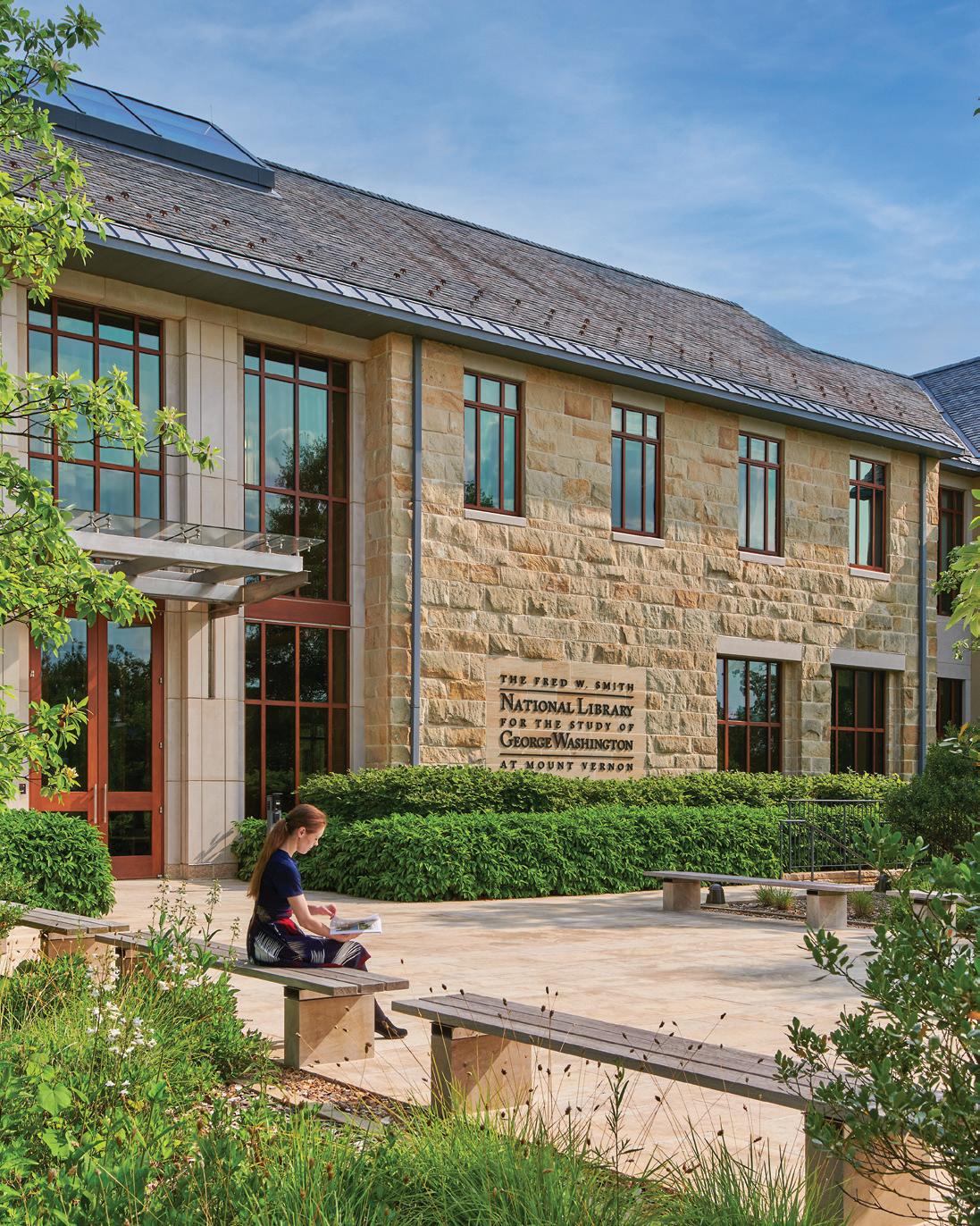



Washington’s bookplate, pasted in some of his books, has a design based on the Washington family coat of arms.
1
Located on his original farm and holding 32,200 bibliographic records, the George Washington Presidential Library is the foremost repository for knowledge about the founder and first president. It has responded to 16,300 research inquiries, fostering a culture of knowledge exchange, and it has welcomed scholars, educators, professionals, and the general public through its many programs.

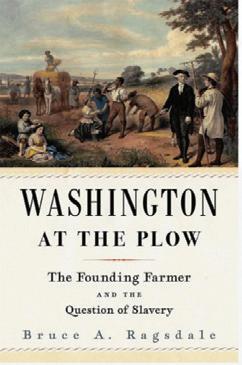
2 The prestigious George Washington Prize (right) honors the best literary works on the U.S. founding era with a $50,000 award. Since 2005, 18 winners have been recognized—including the
two most recent, shown at left—while more than 60 authors have received recognition for their contributions to historical scholarship.
3
The Library has hosted 1,135 teachers in residence and engaged 2,791 educators through various programs. Some 2,705 students have participated in a Librarysponsored award for National History Day. What’s more, 44,497 hours of face-to-face programming by Mount Vernon staff, plus 9,445 hours by education

partners, have enriched the learning experience for many.
4 Library programming has included some

it has engaged colleges and universities, federal agencies, and trade associations, and imparted the qualities exemplified by the revolutionary general and first U.S. president to some 14,200 participants.
6 The Library has hosted 171 research fellows, 38 Life Guard teacher fellows, and 77 leadership fellows. These fellowship programs have enabled in-depth exploration of George Washington’s world across a wide range of topics through one- to six-month terms. Fellows have come from within the U.S. and across the globe, including England, Scotland, Brazil, Spain, Germany, France, and Australia.
221 events, representing a rich variety of intellectual exchanges. Notably, it has hosted three international symposiums and two annual symposiums exploring diverse topics in decorative arts, architecture, and landscape design, as well as annual Founding Debates and monthly book talks.
5 The George Washington Leadership Institute has emerged as a premier platform for cultivating the necessary skills of future leaders. Through its 495 programs,
donations, constructed at a cost of $45 million, and opened in September 2013. The LEED-certified building’s interior features a veneer mostly sourced from a single American sycamore tree.
The Center for Digital History has served as a valuable resource for 15.5 million virtual visitors. It has created 587 entries in the Digital Encyclopedia of George Washington, allowing anyone to explore primary sources from the Mount Vernon collection. The Center also reaches new audiences through

podcasts: The awardwinning Intertwined: The Enslaved Community at George Washington’s Mount Vernon (above) has garnered more than 47,900 plays, while Conversations at the Washington Library has amassed more than 250,000 plays.
7 Set amid 15 acres of original Washington farmland, the Fred W. Smith National Library building blends into the natural Virginia landscape. It was funded entirely by private

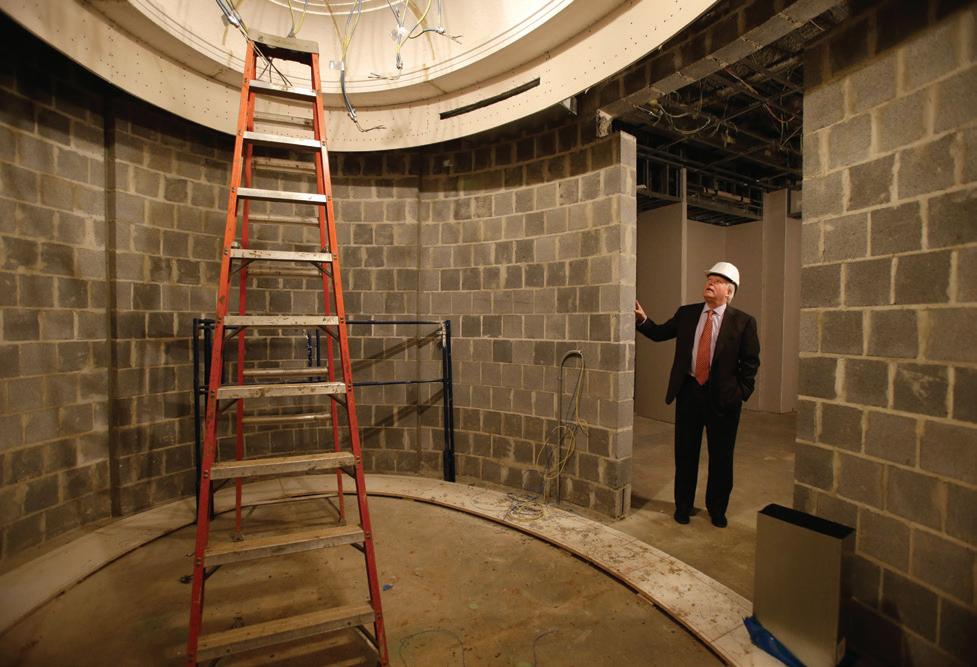
9
In 1968, the MVLA, in collaboration with the University of Virginia, embarked on a monumental mission to transcribe and annotate George Washington’s existing correspondence. To date, the George Washington Papers Project has published 75 volumes of a projected 92, compiling some 135,000 documents. This collection stands as one of the most significant and comprehensive repositories of American historical manuscripts in existence.
In the last decade, the Library has added more than 500 items of Washington-related printed memorabilia, spanning the years 1793 to 2009. The eclectic collection of ephemera includes invitations, children’s books, advertisements—even a garter belt—offering glimpses into how George Washington’s legacy has shaped popular culture and society.

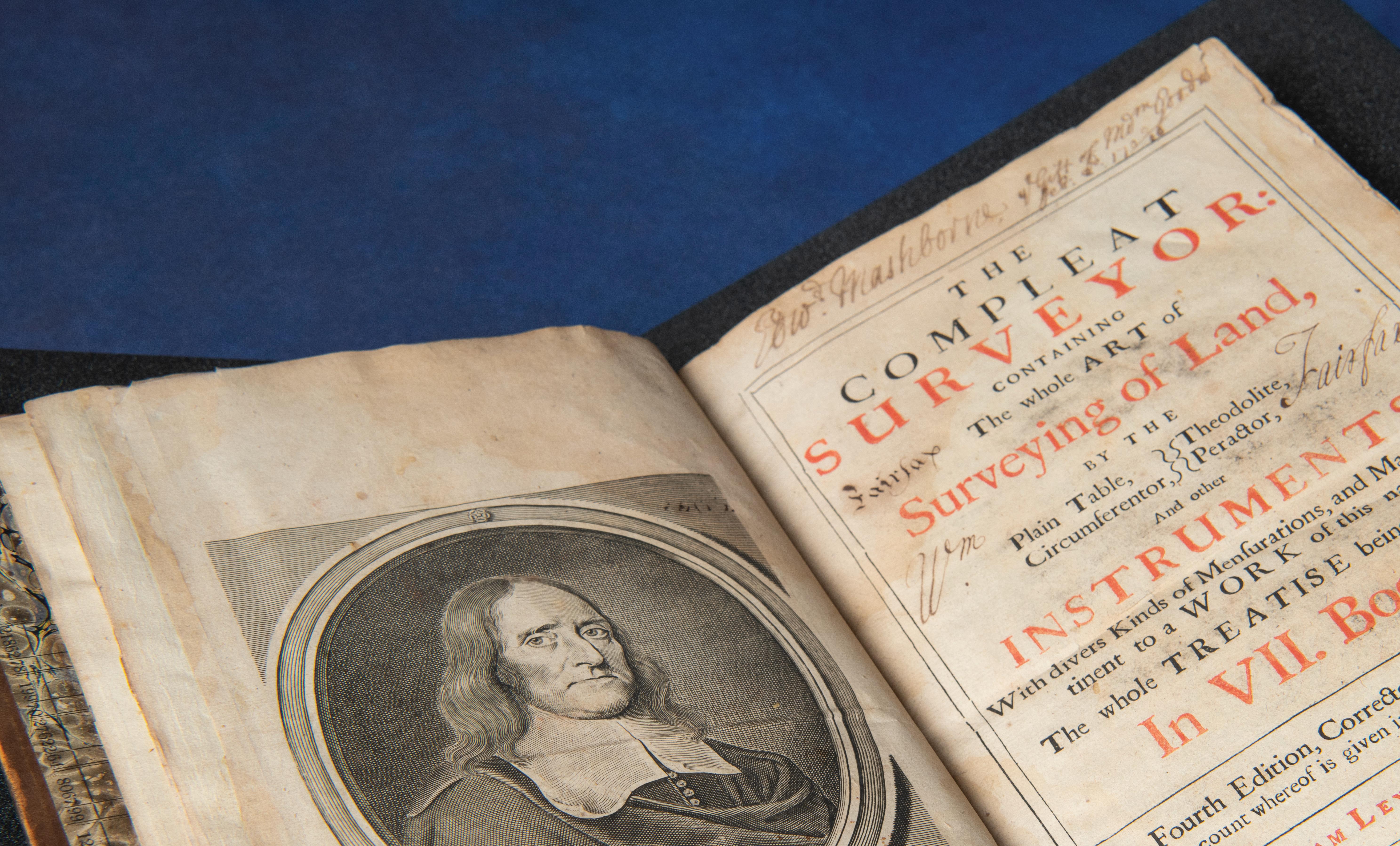
One hundred fifty years ago, the Ladies began collecting original Washington books and documents, as well as the scholarly resources necessary to preserve the Mansion and its history. Over time, this educational mission expanded to include all aspects of George and Martha Washington’s world. Within the Library’s Special Collections today are thousands of documents and rare books, including 105 volumes that belonged to the Washingtons, more than 1,500 maps, and letters from fellow founders such Thomas Jefferson and Benjamin Franklin. You can find everything from Thomas Paine’s Common Sense to a children’s book about hippopotamuses named George and Martha. Here, we’ve pulled a sampling of items from this very special collection.
A VALUED RESOURCE AT THE FARM
Possibly the oldest colored periodical in the world, The Botanical Magazine by William Curtis was known for its vivid illustrated prints of plants from around the world. Washington

maintained a small botanic garden within the walls of the upper garden and in a small green space near the spinning house, almost out of view. Here, perhaps with the aid of one of his gardeners—such as Johann Christian Ehlers, William Spence, or the enslaved men Bristol or George— Washington experimented with new and imported varieties of plants. The

Washington Library currently holds Volumes 1, 2, 5, 6, 7, and 8, which were owned by Washington and passed down to his step-granddaughter Eleanor Parke Custis Lewis.
THE JEWEL OF THE COLLECTION
One of the most historic works in George Washington’s library, this 1789 printing of the Acts of Congress includes the founding documents of the American republic: the Constitution, the Bill of Rights, and the laws passed during the first session of the first Congress of the United States. These laws include the acts establishing the Supreme Court and federal judiciary, a federal post office, and the Departments of State, the Treasury, and War. Washington did not usually write in his books, but in the margins of the Constitution, he noted his official responsibilities by writing “President” in four places, “President Powers” at another, and “Required” next to Article II, section 3, which states that the president Washington’s
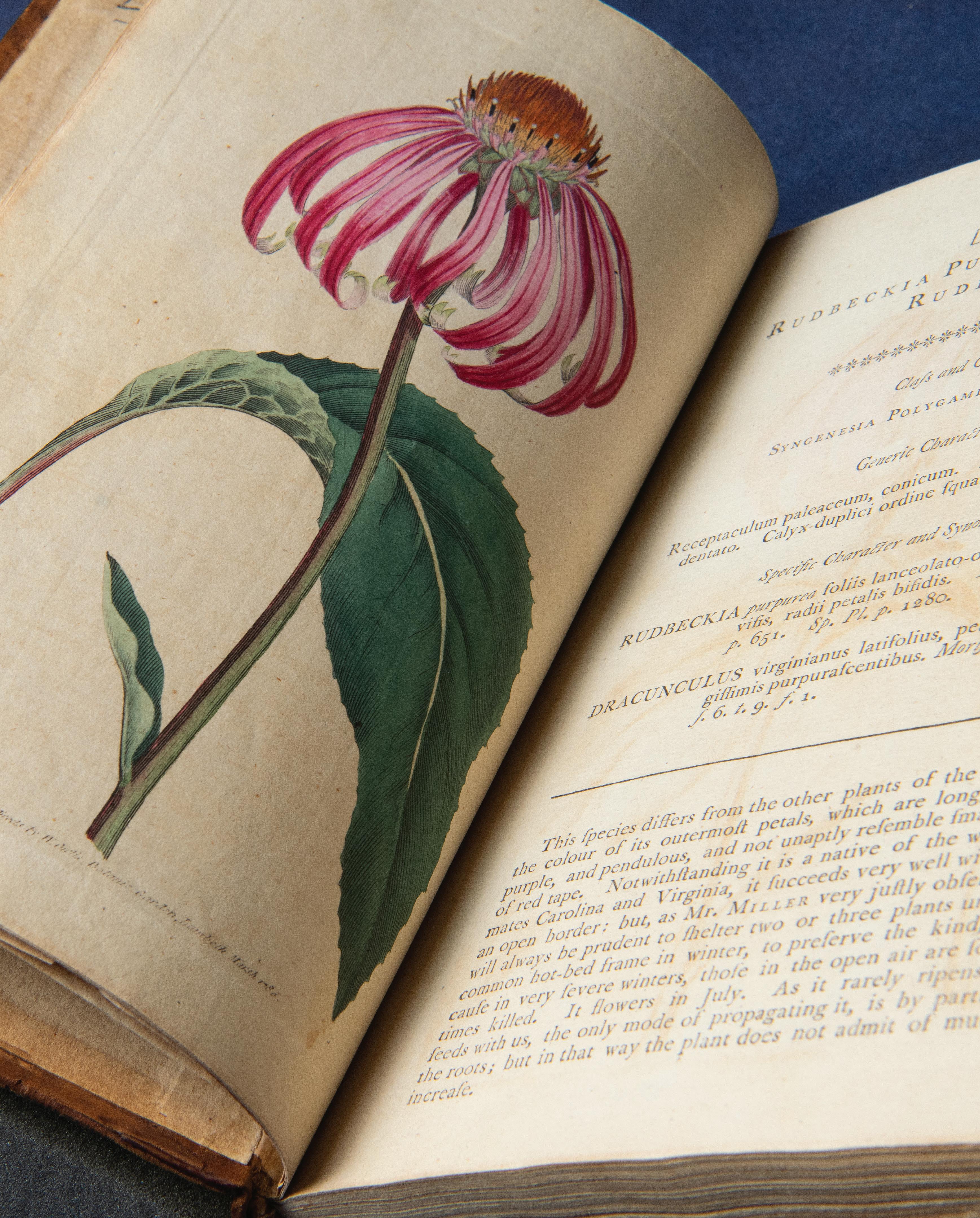
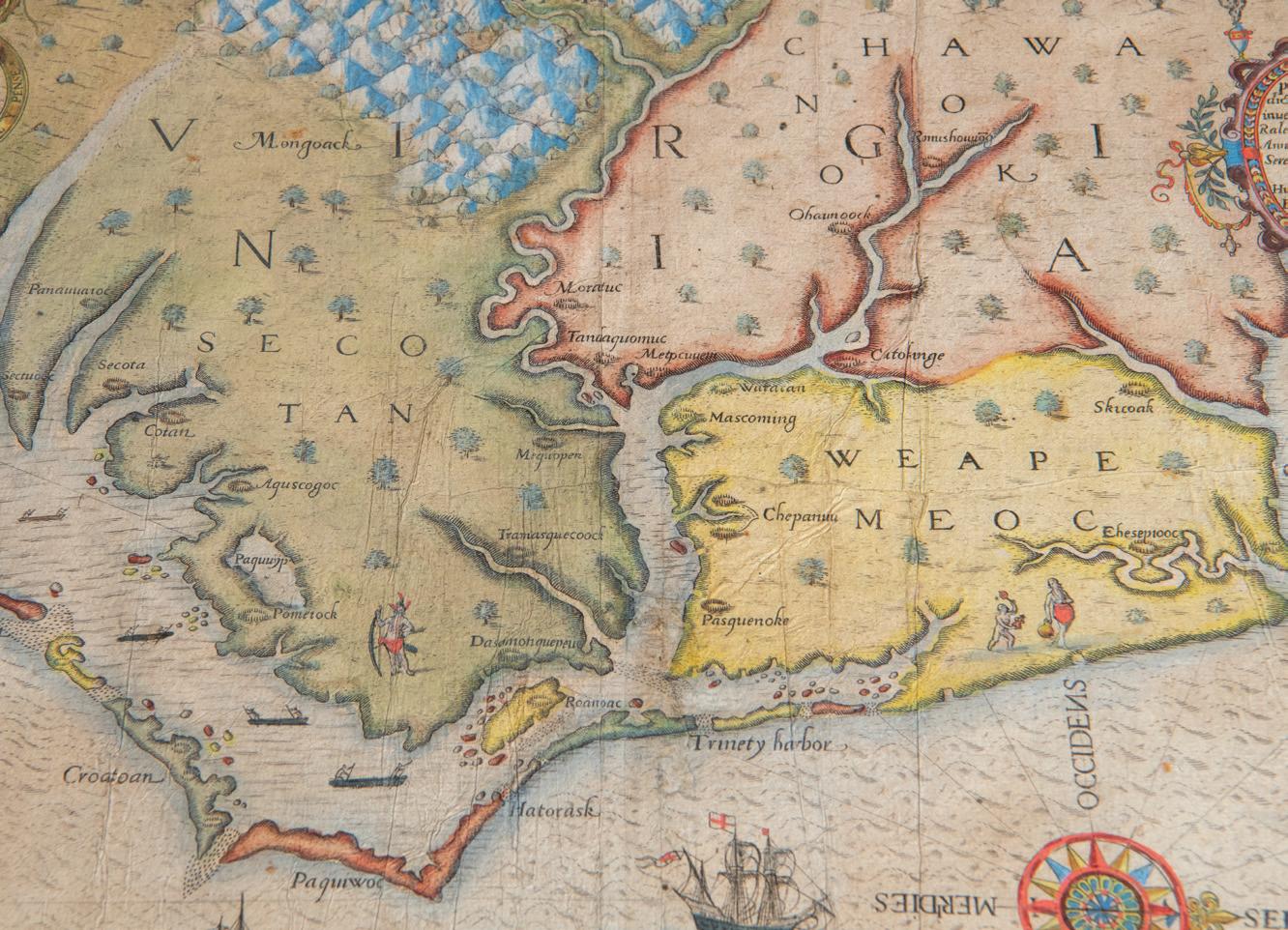
“shall, from time to time, give information to the Congress on the state of the Union.”
Theodore De Bry’s 1590 engraving of John White’s manuscript map (“Americae Pars, Nunc Virginia Dicta”) was the first finely detailed view of a North American landscape. It depicts English claims to Virginia, which at the time encompassed both modern Virginia and North Carolina. Created in the wake of the failed English settlement at Roanoke Island, De Bry’s color engraving visualizes English understanding of Indigenous political communities such as the Secotan, Chowanoke, and Weapemeoc. Illustrated ships heading into the Chesapeake Bay suggest future pathways for settlement and commerce.
Martha prayed from this book twice a day up until her death.
This 1790 Book of Common Prayer contains daily lessons and prayers, as well as a Psalter. It was an essential text of the Anglican Church, and ministers were required to use it in services to ensure uniformity of Anglican worship throughout the British Empire. The faithful also often referred to the Book of Common Prayer for personal worship. This edition in particular was one of the first American versions, published after the American Anglican Church formally separated from the Church of England following the American Revolution. The Washingtons attended local Anglican churches throughout their lives. Martha signed her name on the first page of the volume. According to her granddaughter Eleanor Parke Custis Lewis,
This is Washington’s copy of the first American edition of William Guthrie’s A New System of Modern Geography and its accompanying maps. Washington had owned an earlier British edition, writing, “As to the European Publications respecting the United States, they are commonly very defective…. Guthrie, though somewhat better informed, is not absolutely correct.” When Philadelphia printer Mathew Carey requested to reference Washington’s maps for an “improved” edition in 1793 that would include more content focusing on the United States, Washington enthusiastically agreed. Carey’s edition added 21 maps of America using Washington’s maps as sources. The Washington family had three subscriptions to this project: one for Martha, one for George, and one for his nephew, Lawrence.
Land surveying was George Washington’s first profession, from ages 17 to 20. Washington acquired several books on surveying during his lifetime, but this standard text by William Leybourn came from
the library of the Fairfax family, who sponsored Washington’s entry into the field. It seems Washington borrowed the book, but never returned it. The title page has the signature of William Fairfax, who oversaw the vast landholdings of his cousin Thomas, Lord Fairfax, in Virginia’s Northern Neck. As the title suggests, the book purports to include everything someone needs to know to be a successful surveyor, including geometry, trigonometry, methods of measuring distances over difficult terrain, how to represent and color topographical figures on a map, and basic property law. The volume’s marginalia includes practice calculations and experiments with watercolors,
possibly in Washington’s hand.
Printed in 1679, this is the oldest George Washington book in the Library’s collections.
A LONG-LOST FRAGMENT REUNITED
In 1797, George Washington began building a rye and corn whiskey distillery at Mount Vernon’s Dogue Run Farm following the recommendation of his farm manager, James Anderson. The estate’s Potomac fishery salted and barreled millions of fish a year, but the distillery was particularly profitable. This ledger shows production of whiskey grew each year, expanding from two
stills to five. In 1797, the distillery produced 600 gallons of whiskey, and nearly 11,000 by the end of 1799, making Washington the nation’s largest whiskey producer.
In 2003, Mount Vernon acquired a manuscript fragment with the date October 27, 1799, and George Washington’s signature. The auction catalog indicated it had been removed from a ledger book. A staff librarian realized this fragment matched a missing piece from the ledger.
This fragment shows how meticulously Washington reviewed the accounts. The account noted that the balance in his favor was 395.40. Washington added a note: “Error this balance is only 375.40.”


HANDWRITTEN BY WASHINGTON
Shortly before drafting his will, George Washington compiled a list of all the enslaved people on Mount Vernon’s five farms. He included their names, work assignments, ages, spouses, and children. He listed these people in two columns: “G.W.” referred to those he owned directly, whereas “Dower” indicated those owned by the Custis estate. This distinction was important. Neither Washington nor his wife had the legal authority to emancipate the Custis slaves. The manumission provision in Washington’s will

applied to only those in the “G.W.” column—123 of the 317 enslaved people at Mount Vernon. Washington predicted that freeing his own slaves would have “painful consequences” because of their “intermixture by marriages” with the Custis slaves.
Considered one of the most magnificent printed publications in the world at the time, this edition of Miguel de Cervantes’s novel Don Quixote was just one of a number of fine gifts to Washington from Spain. Benjamin Franklin owned a copy, and in 1787, the Spanish ambassador Diego Maria de Gardoquii presented a similar copy to Washington, writing that he “recolectt to have hear’d you say at Dr Franklin’s that you had never seen it.” That same conversation at Franklin’s home may have prompted Washington to purchase his own English translation of Don Quixote on the last day of the Constitutional Convention. Gardoqui had hoped that the gift would encourage Washington to intervene on the issue of navigation rights on the Mississippi River. A private citizen in 1787, Washington thanked Gardoqui, but declined to involve himself in government business.
Martha Washington received many letters of condolence after her husband’s death. In this heartfelt
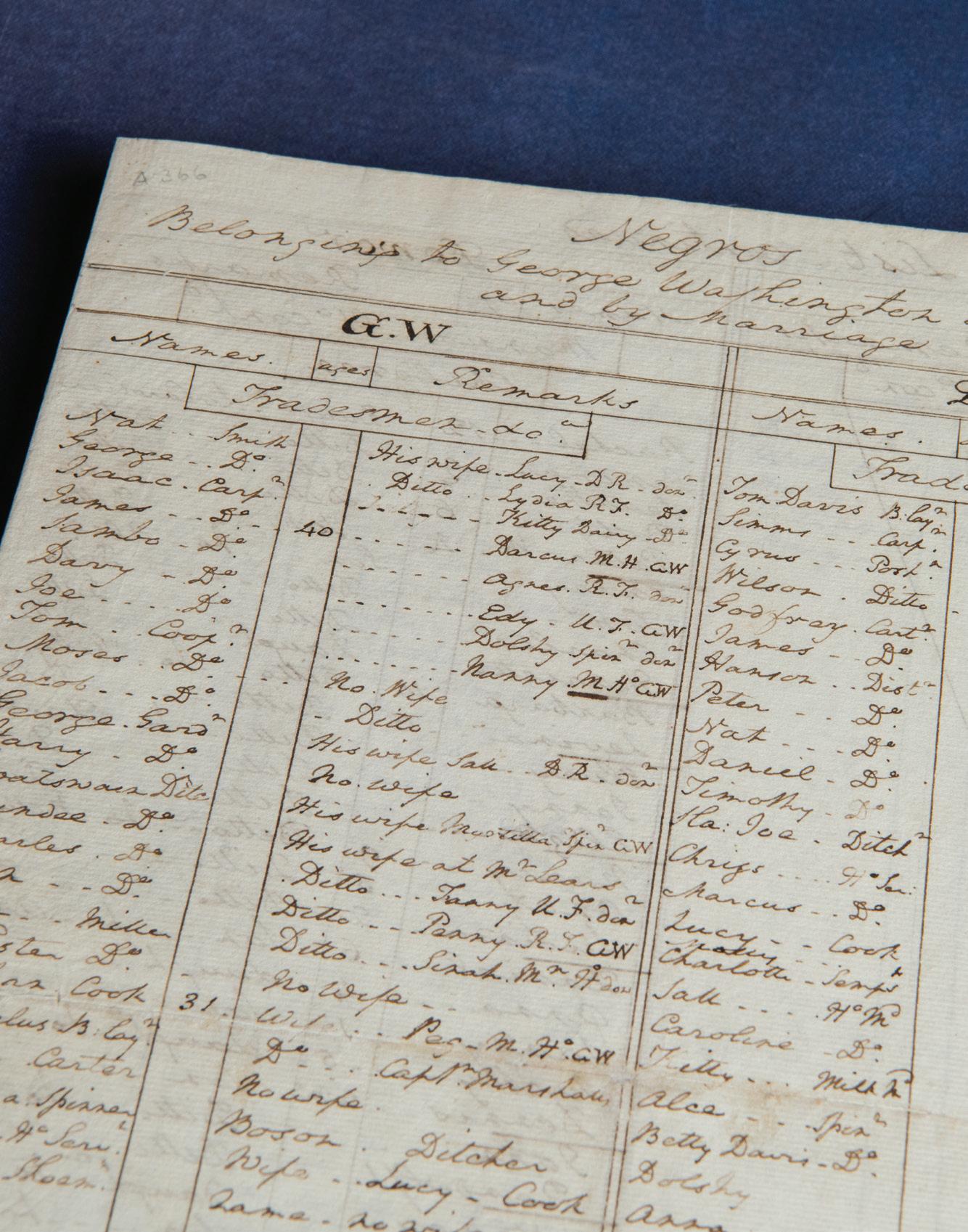
made a list of the enslaved people “belonging to” him and his wife.
letter, Lafayette tells Martha that he understands how difficult it must be to lose her husband, because he knows they were “United in Every thing,” including the “Parental Affection” George and Martha extended to Lafayette and his family. Lafayette touches on the many difficulties he, his family, and his friends have experienced during the upheavals of the French Revolution, and says that he has used Washington’s example as a guide, and his memory as an inspiration, during the challenges he has faced.
Dana Stefanelli is the curator of special collections at Mount Vernon.
How the Items Came to Mount Vernon Census of Enslaved Workers, 1799: Purchase, 1947. Martha’s Book of Common Prayer: Gift of George Thomas through Mrs. Charles C. Harrison, Vice Regent for Pennsylvania, 1903. The Botanical Magazine: Bequest of Marie Worthington Conrad Lehr, 1922. A New System of Modern Geography: Gift of Mrs. Mary Starling Payne, 1893. Don Quixote: Purchase, 2012. The Compleat Surveyor: Purchased with funds provided by Eleanor Seaman, Vice Regent for Wisconsin, in honor of Sarah Miller Coulson’s time as Regent, 2018. Distillery Ledger and Recovered Fragment: Purchased with funds donated by Mr. and Mrs. Robert A. Best of Omaha, Nebraska, in 1996 and 2003. Acts of Congress: Purchase made possible through lead donations by an anonymous benefactor, Mr. and Mrs. William H. Borthwick, the Alfred Taubman Fund, Mr. Terry S. Kohler, and the Mount Vernon Ladies’ Association, 2012. Condolence Letter: Purchase made possible through a lead gift from Mrs. Forrest E. Mars, Jr., with additional support from William R. Kenan, Jr. Charitable Trust and the A. Alfred Taubman Foundation, 2012. Americae Pars map: Gift of Mr. and Mrs. Paul Schott Stevens, 2020.

THE WOMEN WHO SAVED GEORGE WASHINGTON’S MOUNT VERNON HAD
THE FORESIGHT TO DOCUMENT THEIR STORY, TOO
by rebecca baird
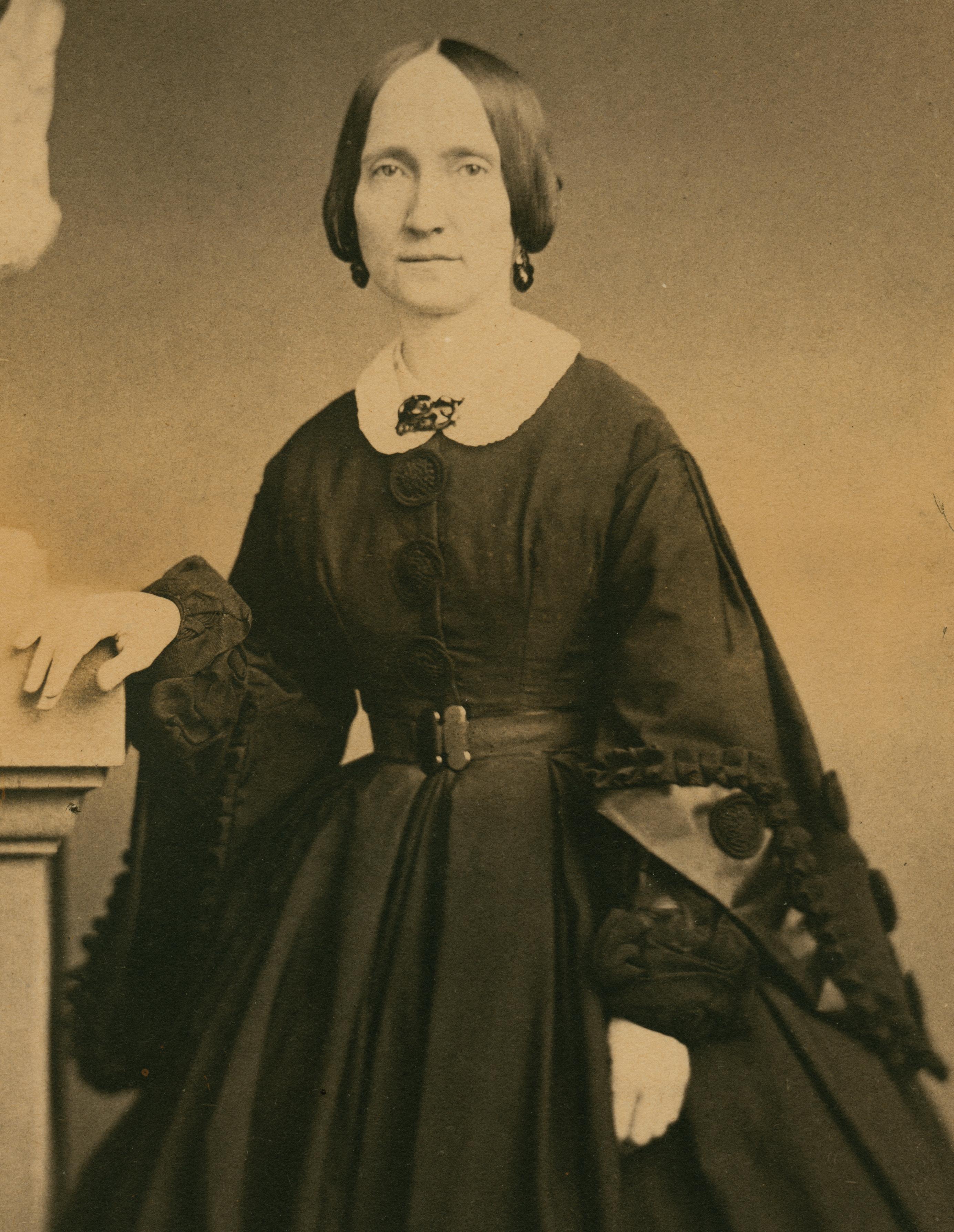
If the need to preserve George Washington’s home seems obvious to Americans today, it wasn’t always so, and certainly not before the historic preservation movement in the United States. And as both the rescuers of Mount Vernon and the first national organization devoted to historic preservation, the Mount Vernon Ladies’ Association (MVLA) plays a key role in the larger American story. Only in hindsight is it clear that their papers were worthy of preservation also. Fortunately, the founding Ladies of the MVLA had the foresight to save, store, and organize their own institutional documents, along with Washington’s, and set a precedent for future generations. Today, these important records are housed at the George Washington Presidential Library. The documents remain a rich primary source of information that describe Washington’s evolving legacy, the journey toward learning and setting preservation standards, and the commitment of Mount Vernon’s staff and caretakers.
Mount Vernon, the home and tomb of George Washington, has attracted tourists since the early 19th century, soon after the death of Martha Washington. But the condition of the Mansion and grounds declined as later owners, all Washington family members, found it difficult to make the extensive estate profitable. In the 1850s, seeking a responsible buyer who would preserve the home of the founding father, George Washington’s greatgrandnephew John Augustine Washington III offered to sell Mount Vernon to the State of Virginia or to the federal government. Neither expressed interest. Enter Ann Pamela Cunningham, a woman from South Carolina whose mother had told her of the derelict condition of the first president’s home after traveling by it in 1853. Cunningham decided to do something. She soon marshaled a group of women from across the country

and founded the Mount Vernon Ladies’ Association of the Union, turning the restoration and preservation of Mount Vernon into her life’s mission. The women began raising money to buy the property. In 1858, after years of organizing, fundraising, and persuading John Augustine Washington III, the organization signed an agreement
to purchase Mount Vernon for $200,000 and formally took control of the estate in 1860. Some 170 years later, the Association continues its stewardship, its mission unchanged.
The care and maintenance of Mount Vernon as a shrine to George Washington were always the MVLA’s
primary focus. However, Ann Pamela Cunningham quickly realized the importance of chronicling the story behind the saving of Mount Vernon and of the pioneering women who did so. Unfortunately, poor health prevented her from writing about the history of the organization, and she died before making any real
progress. Cunningham did ensure, however, that future generations could fulfill this task. In a codicil to her will, added only two months before her death, she instructed that her papers, “which are of a private character, and yet may be of public importance,” be turned over to three women, including two Vice Regents, Margaret Comegys of Delaware and Letitia Walker of North Carolina.
She specified these documents be “used judiciously in the preparation and preservation of the history of the said Association.” Totaling several thousand manuscripts, this collection of correspondence, financial records, and public appeals became the foundation for the MVLA archives. This set a precedent for the Ladies who followed. As Vice Regents retired or died, their papers were forwarded to Mount Vernon. Former employees submitted relevant MVLA documents as well. Susan Pellet, one of the first secretaries of the Association, and George Riggs, banker and first treasurer, provided some of the earliest material in the archives.
The arrangement and cataloging of all these documents fell to the Vice Regents themselves. The two Vice Regents to whom Cunningham entrusted her papers formed the first committee to review and sort through them. Reporting on their efforts to the MVLA Council, Margaret Comegys stated, “Mrs. Walker and myself have arranged the papers according to our best judgement, guided by the recollection of conversations with Miss Cunningham.” By 1883, one of the standing committees outlined in the MVLA bylaws was the Committee on Records. Its essential duty was “to keep a written list of all records, and where deposited, and report in writing what records of importance are in their keeping.” Members filed away documents and kept lists of box or folder contents. They sought to fill gaps in the historical record. In a couple of cases, committee members found it necessary to approach the families of deceased Vice Regents to retrieve important records. After the death of Philoclea Eve, the first Vice Regent for Georgia, the Records Committee asked the Council “for authority to demand from the executors of the late Mrs. Eve all books and papers of the Association that were in her hands.” Papers concerning the MVLA founding— referred to as the “early records”—were considered the most important, along with official minutes, financial and legal records, and provenance documents used to prove the

“May I beg of you, dear ladies, not to destroy everything that may in the future bear on the history of the Association and give you some personality.”
—Rosamond Beirne, Regent and Vice Regent for Maryland, 1953
The MVLA archives hold a variety of records, including letters, financial documents, photographs, reports, and ephemera.


authenticity and ownership of Washington artifacts.
For many years, only the Ladies themselves or the superintendent could access the MVLA’s archives, as the records contained information deemed “sensitive” or “private.” Vice Regents who served on the Records Committee met before or after their formal annual meetings, or Council, to organize the papers of their predecessors. Most found the work to be tedious, but occasionally fascinating. In 1935, the Regent and two members of the committee arrived a week before Council, commuting daily from Washington, D.C., to Mount Vernon, to read and file the backlog of records. The committee chair, Mary Van Deventer of Tennessee, reported, “While the work has been an arduous one, it has been most interesting and has given to all three of us many hours of pleasure and real amusement.” In 1924, writer Grace King, sister of the Vice Regent for Louisiana Annie King, was granted permission to examine the early records for her book Mount Vernon on the Potomac: History of the Mount Vernon Ladies’ Association of the Union. Others were later
allowed access for research and publications.
The Records Committee continued to remind succeeding generations of Ladies to keep track of their papers and return them to the Association after retirement. It started a photo album of Vice Regents in 1893, asking each to select a favorite likeness for inclusion. The centennial of the MVLA in 1953, which featured an exhibit of objects and documents from the founding years of the organization, demonstrated the value of these efforts. The plea at Council that year by acting chair Rosamond Beirne of Maryland was especially striking:
“It may not seem important at the moment to have this material at hand but when we have departed it is definitely late for a record and we become a research problem. Won’t you please help the future committees by becoming a Record and not a Research problem?” Another entreaty came only two years later, also by Beirne, “May I beg of you, dear ladies, not to destroy everything that may in the future bear on the history of the Association and give you some personality.”
Finding appropriate storage for their records was a constant problem for the Association; records were initially held in an iron safe in the superintendent’s office. The items regarded as the most valuable, including some original Washington manuscripts, were transferred to a safety deposit box in a Washington, D.C., bank. The salt house, one of the Mansion outbuildings, was “fireproofed” in 1922 for the safe storage of relics. But when the collection of Washington-related artifacts outgrew the space and moved to a new museum building in 1928, the salt house later became the “Archives,” complete with two safes and steel filing cabinets. It housed an expanding variety of materials, such as photographs, blueprints, maps, postcards, pamphlets, and staff reports. The Archives remained in the salt house from 1935 until the early 1960s, when portions of it were gradually relocated around the estate, mostly in offices or administrative rooms, with the intention of bringing all library and historical paper records together at some future date. Supervision of the archival materials was eventually handed over to staff. Mount Vernon hired its first professional librarian, Irene Warren, in 1940. One of her key responsibilities was indexing the MVLA’s Council minute books and the early records. The files and papers of the Vice Regents passed through the hands of many later librarians, archivists, and assistants in an effort to classify the large volume of records. However, these same employees also cared for the Association’s reference library and Washington-related manuscripts and books, which were often seen as a higher priority than the Association’s collection of records.
Finding appropriate storage for their records was a constant problem for the Association; records were initially held in an iron safe in the superintendent’s office.
In 1983, the archives moved into the basement of the new Ann Pamela Cunningham Building, an administrative building, as part of the Library and research center. And in 2003, the MVLA—and its records—were once again in the spotlight. The organization’s 150th anniversary was marked with an exhibit at the National Building Museum in Washington, D.C., and in a large-format book filled with historical photographs and documents.
Today, this collection of institutional records, deliberately and painstakingly assembled throughout the years, rests safely within the George Washington Presidential Library, where it benefits from modern preservation techniques, including climate control and acid-free boxes. Research fellows, scholars, students, and Mount Vernon staff can all take advantage of the foresight of Ann Pamela Cunningham and succeeding generations of women who understood the value of preserving their own story within the larger context of an American icon.
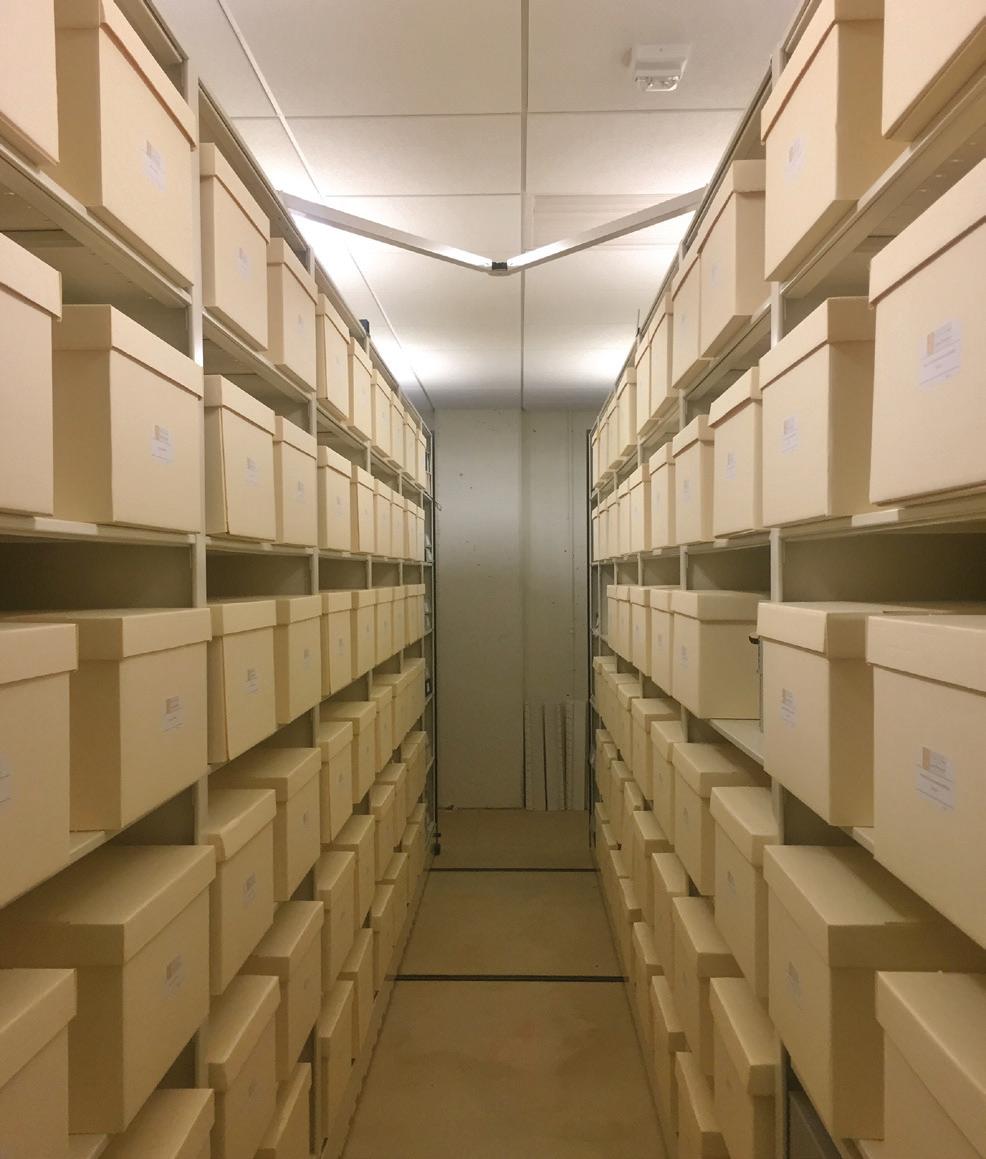

After more than two decades in the classroom, Melaney Sanchez, Ph.D., transitioned seven years ago to the library as a “teacher librarian” for kindergarten through fifth grade at Mount Harmony Elementary School in Calvert County, Maryland. “I can support the educational staff and have every student for their entire elementary career,” she says. “I adore my job and the possibilities it brings for programming and cultural arts.”
Q: How do you bring George Washington and Mount Vernon into library activities? After attending the “First in Business” session at the Mount Vernon Teacher Institute in 2019, I began to compile resources and books that
would complement each grade level. I planned lessons and utilized the Mount Vernon YouTube channel and interactive tools. I worked with the music teacher to have students learn songs they could perform for our schoolwide Washington Night. We hosted a “wax museum” that night for which students chose key historical figures such as Samuel Prescott, Paul Revere, Deborah Sampson, Benjamin Franklin, Margaret Corbin, John Hancock, and Lord Cornwallis, to name a few. Students prepared a monologue, and when approached, they would speak and remain in character to answer questions. The community loved it, and the work of the fifth graders exceeded my expectations.
How do you make 18th-century events resonate with young people? Conflict is powerful and motivating. I have created lessons such as George [Washington] vs. [King] George and had students defend the point of view of each leader. They debate the Loyalist and Patriot points of view regarding Washington, and they thoroughly enjoy learning about how Washington used spies to outwit the British. The Mount Vernon virtual tour supports the lessons I have planned, and the interactive “Be Washington” program is a hit.


Why are experiential learning activities so important for this age group, especially when it comes to historical figures? Many students can recognize George Washington, but their knowledge is limited.
Historical figures must come alive to motivate students to ask for more. When students care they will seek more knowledge, more books, additional websites, and more experiences in and out of school. It’s a thrill to see them take the lead.
What has the feedback been from your students? I know I am on track when at the end of the class students express disappointment that there isn’t more time. And at the end of every community event, students want to know, “What are we doing next year?” This implies that they understand that learning is a lifelong process that should include celebration, integration of the arts, and the entire community.
How have these experiences inspired you? Mount Vernon inspired me with its residential program by enabling me to spend a week with phenomenal teachers from all over the United States. I interacted with extremely knowledgeable
staff who helped us bring Mount Vernon home to our classrooms and libraries. Experiences such as this have a significant impact: They have helped me plant seeds of curiosity and wonder so that students can own their learning and have knowledge that will provide a strong foundation and benefit them for a lifetime. I want students to remember how empowered they felt when they became experts on the lives of key historical figures who shaped the United States.

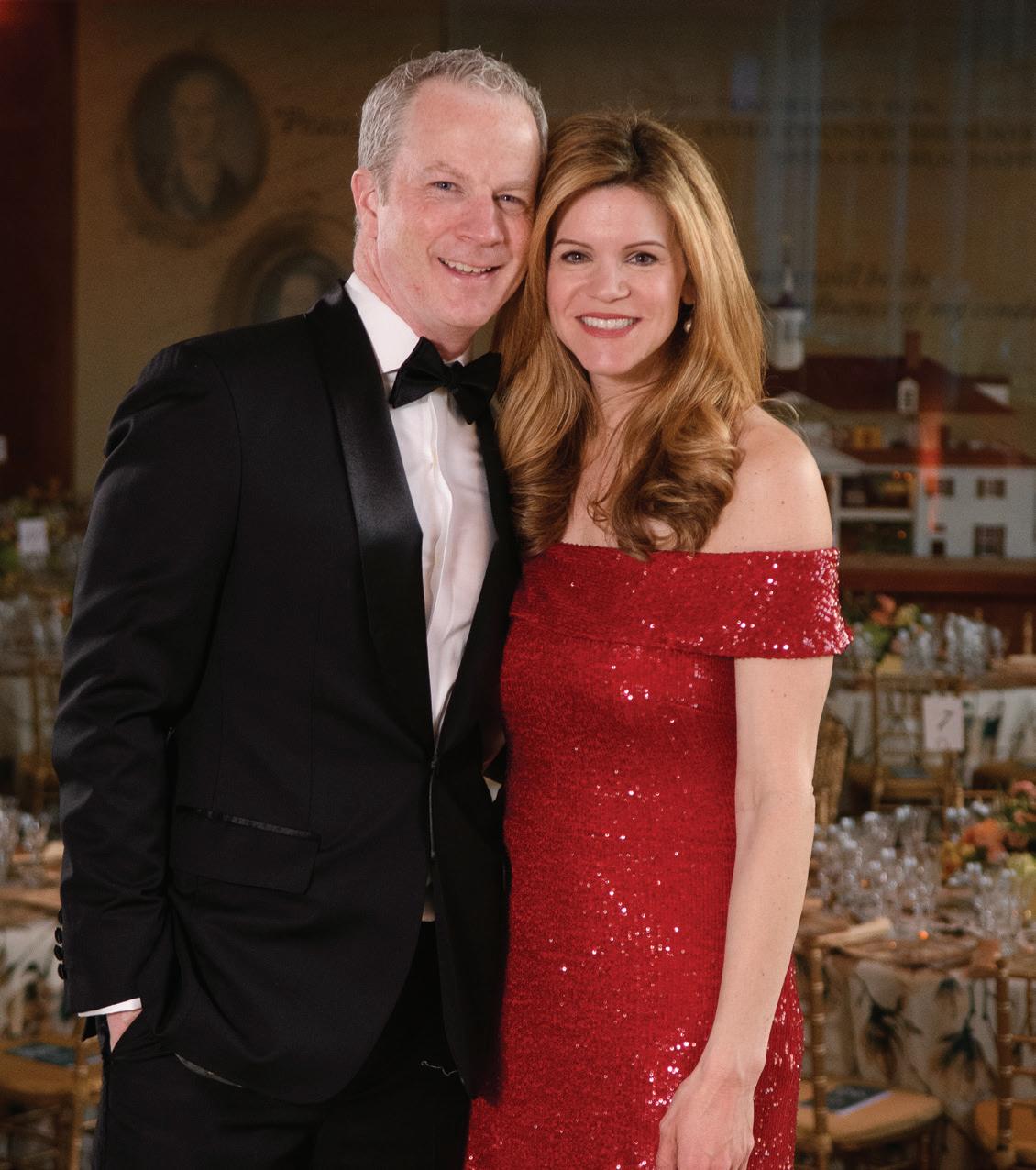

On Sunday, February 19, more than 200 guests attended the 76th annual Birthnight Supper and Ball. This special tradition is Mount Vernon’s longest-running fundraiser. Organized by the Neighborhood Friends of Mount Vernon, the sold-out event raised a record-breaking $311,000 to support the restoration and preservation of the Mansion, making it the most successful Birthnight Ball to date. Event co-chairs Audra and Matt Gannon greeted guests who enjoyed cocktails, an elegant three-course dinner, a live auction,



a paddle raise, live music, and dancing. A highlight of the evening was a birthday toast delivered to General Washington.
The following Saturday, February 25, nearly 200 of Mount Vernon’s most generous supporters gathered for George Washington’s Birthday Dinner. Oksana Markarova, Ukraine’s ambassador to the United States, spoke movingly about the example of leadership set by the first U.S. president. Guests enjoyed a lively exchange between philanthropist David Rubenstein and members of the diplomatic community: Dame Karen Pierce, British ambassador to the United States; Santiago Cabanas, Spanish ambassador to the U.S.; and Aurélie Bonal, the deputy chief of mission at the French Embassy. Caleb Green and Christal Rheam, retired veterans and members of the singing group Voices of Service, entertained during dinner, and Anne Neal Petri, the Vice Regent for Wisconsin, offered an inspiring toast to George Washington.


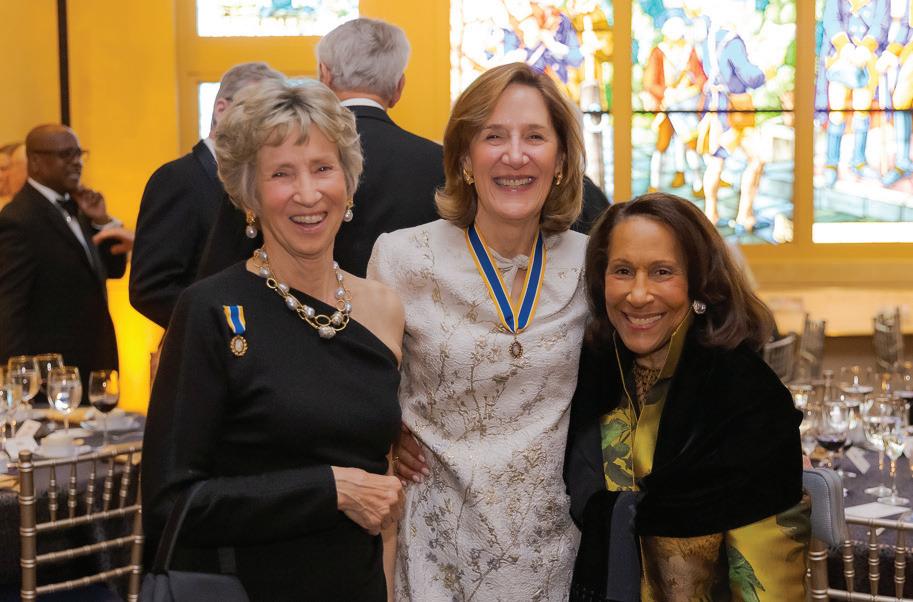

Updates from the Strengthening Our Foundations campaign
Thanks to the support of generous donors through Strengthening Our Foundations: The Campaign for Mount Vernon, work has progressed on many important preservation projects.
The Mansion’s exterior has now been completely restored. Work included replacing windows, stripping the paint off the siding, documenting the boards—many of which date to the 18th century, and alternating coats of paint with the application of sand to achieve the look of stone. Scaffolding was removed in April, and finishing touches on window and shutter restoration continued through the spring. This completes the effort to restore the entirety of the Mansion’s exterior, which started with the 2019 restoration of the west front and the 2021 restoration of the north and south sides.
The first phase of the Mansion Revitalization project—expansion of the underground utility bunker— is underway. This critical effort will upgrade obsolete HVAC systems and enable room-by-room zoning control of humidity and temperature, which will preserve the architectural fabric as well as priceless objects on display.
This multiphased endeavor will revitalize the Mansion by strengthening its foundation, preserving original architecture, opening new areas of interpretation, and creating detailed project documentation. Archaeological excavations will continue throughout the entire revitalization project, preceding any work that involves breaking ground.
Curatorial restorations of various rooms in the Mansion and the preservation of historical outbuildings are also part of Strengthening Our Foundations: The Campaign for Mount Vernon. This comprehensive effort is funding important preservation, education, and endowment projects to ensure Mount Vernon lasts for years to come.
The Founders Committee supports bedchamber restoration project
The Founders, Washington Committee for Historic Mount Vernon, hosted its annual fundraising event on Sunday, June 4. Proceeds supported the restoration of the Mansion’s downstairs bedchamber.
The event provided an opportunity for guests to enjoy Mansion tours, music, views of the Potomac River, a buffet dinner, and conversation. Members of the curatorial staff provided tours of the bedchamber and shared details of the preservation plans for the room.
The downstairs bedchamber dates to the 1730s, when the house was originally built for Washington’s father. The room was likely the principal bedchamber of the mistress of the house in that early layout. Mary Ball Washington, Ann Fairfax Washington, and Martha Custis Washington may have slept in this room at various times. In 1775, George and Martha Washington added a new private bedchamber for their use on the second floor of


the south wing. After that, the downstairs bedchamber became a room for guests and extended family.
The Founders raised more than $180,000 for this curatorial restoration project. The group’s philanthropic support and contributions from other donors will enhance Mount Vernon’s understanding and interpretation of the downstairs bedchamber.
The Founders Committee continues to have a transformative impact on George Washington’s Mount Vernon. Since 1980, this steadfast leadership group has raised funds to support historic preservation and educational opportunities at the estate.




In 1895, the effort to recover and re-create Washington’s library had barely begun

When the MVLA took over the Mansion and estate in 1860, the study’s shelves were bare; Washington’s books had been scattered and sold years earlier. Upon completing much-needed repairs and restoration to the exterior of the Mansion, the Ladies turned their sights inward and commenced the mission of returning original belongings to Mount Vernon. As reported in the 1885 Association minutes, a motion was approved “that a committee be appointed to consider the best methods for filling the vacant shelves of the Library [study].”
Over the years, the MVLA acquired volumes and papers belonging to George and Martha Washington and their descendants, as well as reference materials to support research and scholarship. What began in Washington’s small study grew to become a presidential library fit for the first U.S. president. This image of George Washington’s study from 1895 is indicative of the early years of that process. Among the books on the shelves is The Beauties of the Late Rev. Dr. Isaac Watts, a Washington-owned volume returned in 1886. Other 18th- and 19th-century reference books, often the gift of authors who relished occupying shelf space in the study, were added to the collection.
P.O. Box 110, Mount Vernon, Virginia 22121
I have not houses to build, except one, which I must erect for the accommodation and security of my military, civil and private papers, which are voluminous and may be interesting.
— George Washington to James McHenry 3 April 1797
